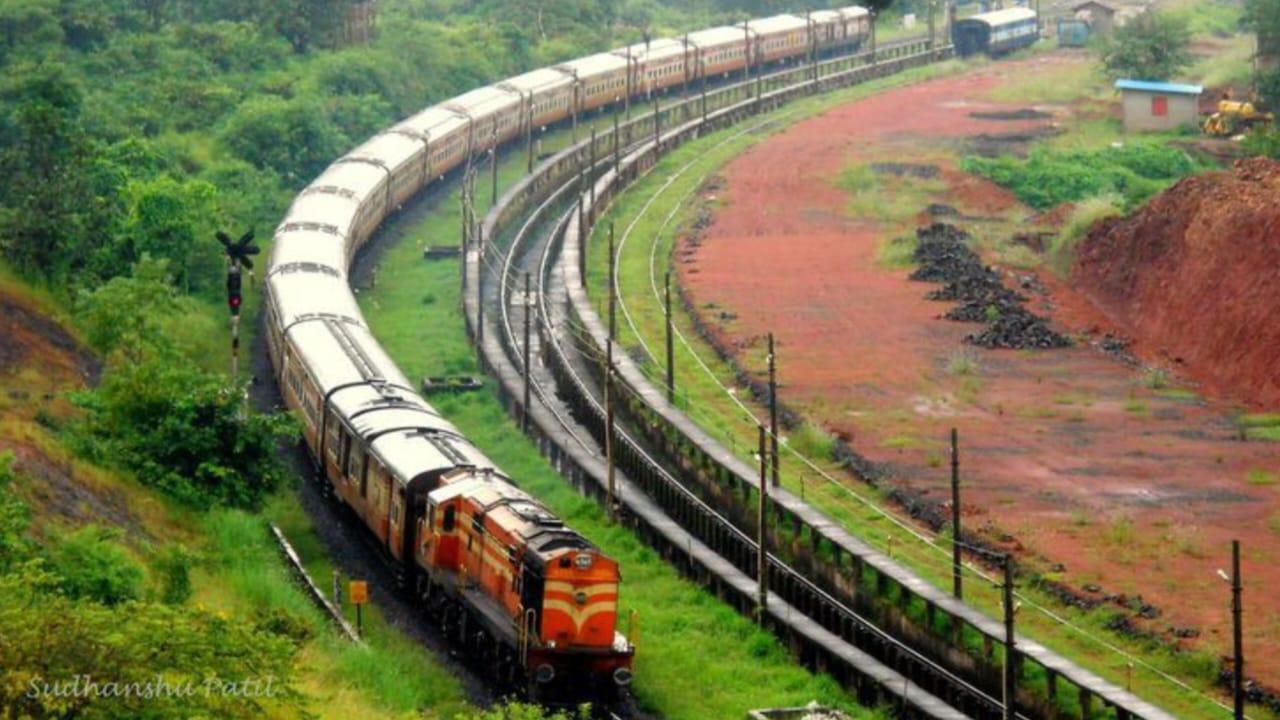Introduction
Railways of the World : Transport has an important contribution in the current socio-economic system of the world. In order to obtain the resources of raw material, shreem and power and to take the finished goods to every nook and corner of the country and to distant foreign countries, means of transport are required.
In addition to industrial work, transport services are also required for carrying passengers. Humans and animals were the main means of transport in prehistoric times. Man used to do the work of bringing and carrying the burden for a short distance.
Even today, animals are being used as heavy loads and for carrying vehicles. Three main means of transport can be developed in an area, land routes, waterways and airways. Geographical, economic and political conditions have a profound effect on the development of land routes in a region.
Roads and railways are important under land routes. The best means of transport in the interior parts of the country is the railways. Railways have played a special role in the economic development of various countries of the world.
The way road has been the oldest method of land transport, rail transport is equally new. The history of its use is only 170 years old. Like roads, in rail transport also a certain route has to be constructed by laying the tracks of the railway track. Similar to paved roads, railway tracks/rail lines create a clear and permanent pattern on the ground. Rail coaches are pulled by engines on these lines. The railway engine and tracks were invented in England.
Not only this, rail tracks were first used to transport coal to coal mines, the first railroad was built in England in 1835 while the first train ran from Manchester to Liverpool and was driven by its creator George Stephenson / Stevenson , who invented the steam engine.
After this, the rail was used in other industrial centers of England, Midland, Lancashire, Scotland’s central valley. With the spread of railways in England, the production of coal increased and along with it the production of iron and steel also increased.
Since then railroads have made great progress in all countries of the world. In fact, rail transport is a product of industrial revolution, it has contributed to the creation of human civilization related to industry, commerce. With the development of rail transport in Western Europe and the United States, industrialization progressed in these countries.
CHARACTERISTICS OF RAILWAYS
Railways play an important role in the economic development of any country. This is important from many points of view-
- Heavy and large quantity of goods are easily transported to remote places by railways.
- This is the foundation stone for the development of industries, because by this the supply of raw material and finished goods is done quickly.
- The train fare is comparatively cheaper.
- Transportation of minerals from remote and inaccessible areas is possible only through railways.
- It is also the cheapest and most convenient mode of transport for passengers.
- Along with the economic development, railways is also a solid part of social and cultural development.
- At present, arrangements for mobile library and hospital are also being made by the railways, due to which this rail transport is also playing an important role in the development of health and education of the people.
- In the context of international trade, this railway works to transport goods from the interior of the country to the port and imported goods from the ports to the interior.
Factors Affecting the Development of Railways
In contrast to the road route, many things are taken into account for the development of the railroad.
- Topography: Topography directly affects the development of terrestrial routes. Due to the flat surface in the plains, it is possible to make the route straight, but as soon as the obstruction comes, the railway route has to be diverted, due to which the length of the route increases. This is the reason that the means of transport take the route of least obstruction. Construction of these routes is difficult in mountainous and plateau areas. The train cannot climb steep gradients. Therefore, railways are constructed along the edge of the high surface shape. Tunnels have to be made in the high hills falling in the way and circular routes are made with the help of slope. While a bridge has to be built when a river comes in the way.
- Climate: Climate also affects the development of railways of the world. land with high rainfall It is marshy. Therefore, there are difficulties in the construction of rails. Similarly later, railroad tracks are uprooted, bridges collapse in the affected areas. In hot areas, the railway tracks are covered with sand and soil, while in extremely cold regions, these railway tracks get covered with snow. Similarly, small firecrackers are released on the railway track to keep the vision clear in the season or in areas with high foggy atmosphere. That is, the railway department has to spend a lot to make the railways transportable and traffic-worthy.
- Economic Factors: Factors like economic growth of the region on the development of railways- more of the population High concentration of trade, industrial progress, etc. also have a definite effect.
- Political Factors: The development of the railway is also done for the purpose of security of the country’s border and increasing national unity, where there are no suitable indications for its development.
Distribution of Railways in the World
Along with the spread of western civilization in the world, rail transport has also spread. expert It is believed that the concentration of rail transport is found only in the regions of present era with mechanical civilization. About 26% of the world’s total railroad is found in the United States. Western Europe and the eastern region of the United States are the regions of the world’s two major dense railroads. The highest concentration of railroads in the US is found east of 100* west longitude.
The reason for this density is related to the residential expansion in this area. The railways have given rise to the conditions of dense population by supporting the industrialization of this region. Passengers are more important in rail transport than goods in the western regions as compared to the eastern regions.
Most of the work of loading goods by railways is done in Russia. Due to the production of minerals in far-flung areas and the manufacture of heavy goods in factories, the work of carrying goods is mostly done by trains. On the other hand, the work of carrying passengers by trains is mostly done in Japan and India. Australia
Most of the railway routes are found along the eastern, south-eastern and south-west coasts. Because the concentration of population is more here. Most of the railroads in South America cross the Andes Mountains. Where the railroad works to connect the Pacific coast and the Atlantic coast.
Due to the extensive desert, dense forest area and plateau surface in Africa, railways have been developed in the northern and southern coastal areas. In Asia, there has been more development of railways in Japan, India and China.
Railways of U.S.A.
In the United States, cross-country railroads have been built to connect the west and east coast regions. There is a network of railways lying east of 1.00° west longitude. 80% of the country’s railway is in this part. Through these routes, the ports of both the coasts are related to the moderately affluent and densely populated areas of the country.
There are few railroads in the western US, as there is little traffic due to the lack of cities and population. Only the Valley of California in the west, and the eastern part of Washington state have small networks of railroads.
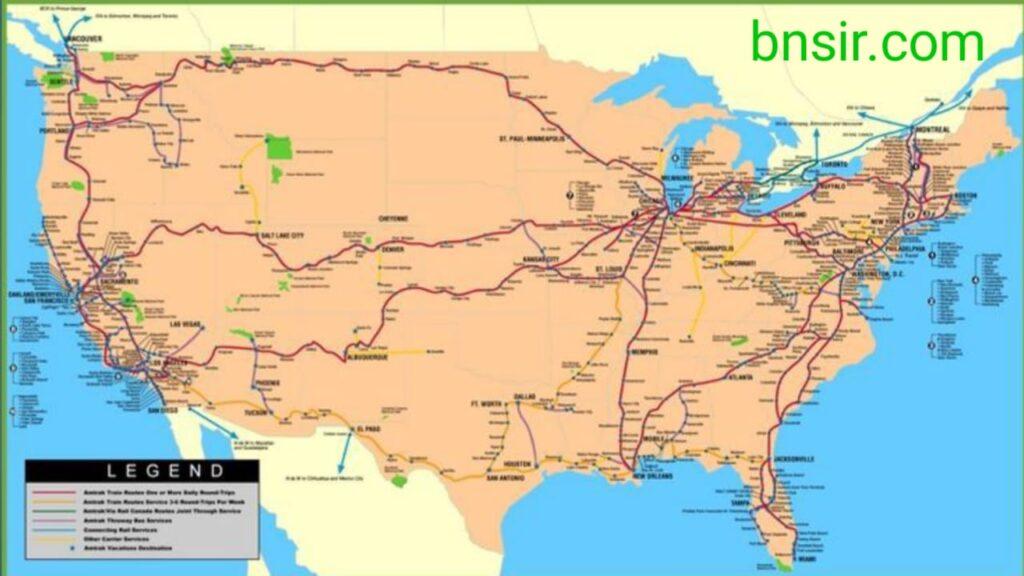
According to the scholars, the pattern of the railways here is mostly a linear pattern. It is a fact worth knowing that first railroads were developed in North America and then settlements were established with their help. Chicago is the largest railway station not only in the United States but also in the world.
The densest region east of the Mississippi River in the US has the largest freight traffic on 5 railroads. gets to These are:
(i) From Cleveland to New York via Pittsburgh and Philadelphia.
(ii) West Virginia to Talladega and Norfolk in the Kentucky coalfields.
(iii) Buffalo to New York.
(iv) Railroads from Buffalo to Philadelphia via Scranton
(v) All the way from Chicago.
In the United States, the main railroads going from the Atlantic coast to the Pacific coast in the east-west direction are –
(i) Northern Trans-Continental Railroad: This railroad starts from the city of Seattle on the Pacific coast in the west and passes through Portland, Minneapolis, St. Paul, Duluth, Milwaukee, Chicago. reaches New York. The bulk of the cargo coming from west to east on this railway is of wood. other goods In the US, minerals, raw silk, tea, canned fish, apples, agricultural products and meat.
(ii) Central Trans continental Railroad: San Francisco city in the west central of the US on the Pacific coast – Cattle are the main. Starting in , this intermediate railroad goes to New York via Salt Lake City, Omoda, Chicago, Pittsburgh, Philadelphia. On this railway, canned fruits, vegetables, wool, animals, meat, etc. are sent from the west to the east.
(iii) Southern Transcontinental Railroad: This railroad running from Los Angeles reaches Albuquerque Is. From here a branch of this railroad goes north to New York via Wichita, Kansas City, Chicago. While the other branch goes south to the Alps, Houston, Galveston and New Orleans. Minerals, fruits, wool, meat, hides, cotton, sugar etc. are sent from the west by this railway to the east.
Railways of Canada
Most of Canada’s land is surrounded by snowy tundra forests, mountains, lakes and unusable areas. Here Most of the population is settled in the narrow belt along the border of United States of America. The development of Nada’s railroads has also taken place along the border of America in its southern part. here is two Continental Railroads.
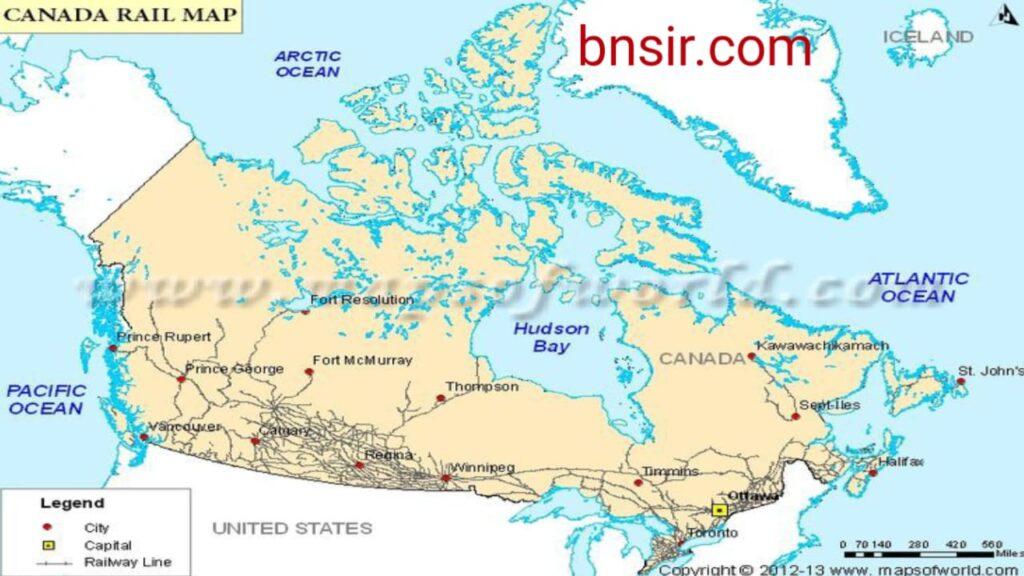
(1) Canadian Pacific Railroad: This railroad starts from Halifax and reaches Vancouver in the west via Montreal and Vinayag.
(2) Canadian National Railroad: This railroad goes from the Atlantic to the Pacific coast, but in the interior areas it serves the centers of Prince Rupert Churchill, Musoni, etc. Wood, raw metals, wheat and coal are transported by this railway.
Railroads of South America Due to the adverse conditions in this continent, the railroads have limited service. The development of railways is found in
(i) Argentina-Uruguay Railroad: This railroad carries goods like wheat, meat, wool, hides etc. from the hinterland of Buenos Aires. There are four railroads in this area which serves to collect the goods of this plain region.
(a) from Buenos Aires to Val Paraiso,
(b) from Buenos Aires to Bolivia,
(c) from Buenos Aires to Bahía Blanca,
(d) from Buenos Aires to Sao Paulo, Rio de Janeiro in Brazil.
(ii) The Brazilian Railway, which runs from Matavideo in Uruguay to Sao Paulo, Rio de Janeiro and Salvador. (iii) Arikudpa in Peru goes south to Lapaz and Mandoza, while the other route goes to Santiago in Chile. And it goes till conception.
Railways of Europe:
In the United States, residential spread is associated with railroads, whereas in Europe, railroads Let’s follow the centers. Although the length of railways is less in Europe, yet the density of railways here is high. Extensive expansion of railways is found from Poland to France and Britain.
All major cities of Europe are centers of railways. In which London, Paris, Berlin are the main ones. The network and density of railways near the North Sea is more. Despite having a network of railways, heavy and large-sized goods are transported in Europe by rivers and canals.
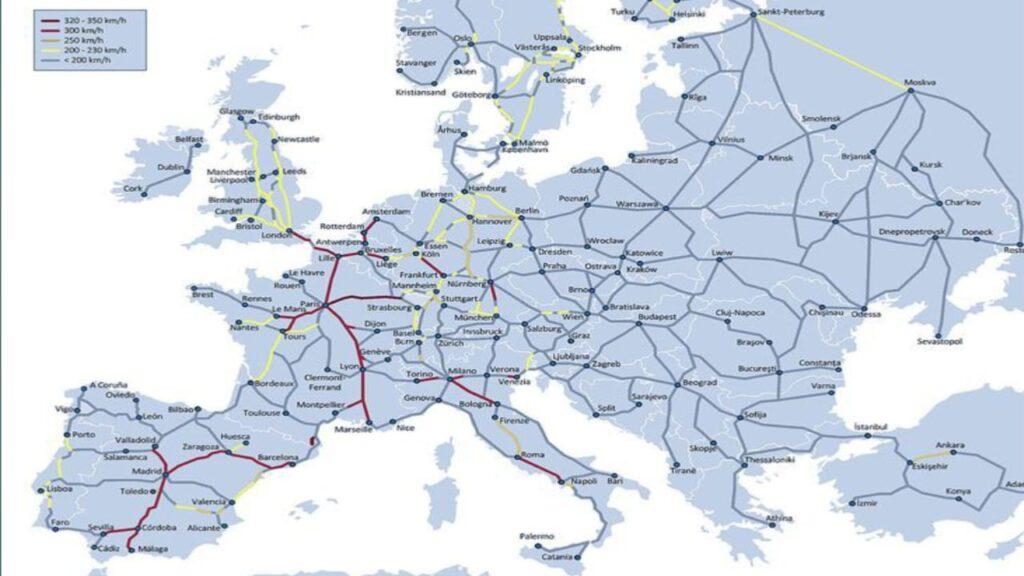
The railroad pattern in Europe is the radial pattern, centered on large cities. From here, the railways go to different directions or the railways come and meet from different directions. The view of military security has also had an impact on the development of railways in small countries of Europe.
Efforts have been made to connect the major cities of the country with the border security centers through railways. International railway routes have been developed keeping in mind the mutual transport and connectivity between these small countries.
Materials manufactured by European railroads include perishables such as dairy, fruit, eggs, meat, etc., heavy materials such as coal, iron ore and other metals, forest produce, and petroleum and petroleum products. And chemical substances are transported.
Important railways of Europe are –
1. Paris-Bon Berlin Warsaw Moscow Railway.
2. Paris-Milan-Brindi Sea Railway.
3. Berlin – Vienna Istanbul Railroad.
All these routes extend to London. Landslides have been introduced in the routes connecting London due to the English Channel.
4. Paris-Milan Rome-Naples Railway.
5. Paris-Prague-Kiev railway line.
6. Southampton Le Havre Paris – Vienna Budapest – Bucharest Railroad D – Istanbul.
7. Paris – Milan – Verona – Belgrade – Railroad.
8. Stockholm-Hamburg Bonn-Milan railway line.
9. Berlin Cologne Paris-Madrid Relmburg.
10. Gdańsk – Berlin Munich – Milan – Rome railway line.
Apart from this, there are many railways in Europe.
Railways of Russia & CIS:
Russia still has the pride of being the largest country in the world in terms of area. Here Most of the country’s territory is plain, due to which the obstacles in the construction of railways are negligible. Some difficulties are in polar and desert areas.
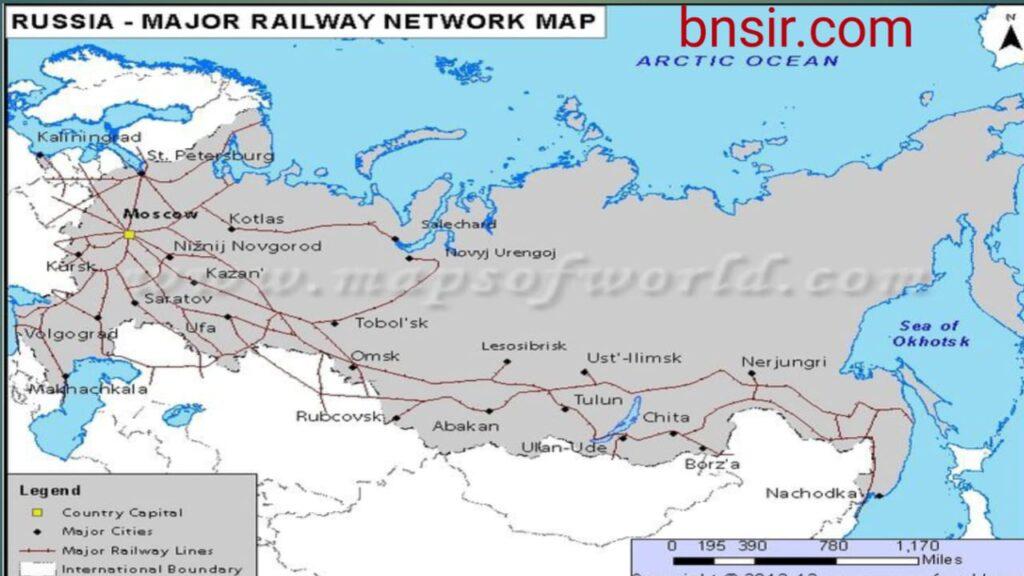
In this country, the stores of minerals and other resources are also far away from the markets and population centers. Therefore, cheap transportation of goods over long distances is possible only through railways. Most of the railways here have been electrified, due to which the cost of coal in the engines is reduced. For all these reasons, there is a good network of railways in this country.
In terms of density of railways, this country ranks second in the world after the United States of America. To the west of the Volga River, there is an area of intensive railroads. Moscow is the center of the railroads. Where the Trans-Siberian Railroad has been developed to connect the Pacific coastal region with the western region.
- Trans-Siberian Railroad: This railroad runs from Leningrad via Moscow to Vladivostok in the east. ,
- Trans-Caucasian Railroad: This railroad runs from Baku station of Baku oil field to Samarkand, Tashkent and Goes up to Fargana.
- Turkmen-Siberian Railway: Starting from Novosievik, this railway goes to Tashkent via the east of Balkara Lake.
- Leningrad Railroad: This railroad goes from Moscow to Leningrad and the Soviet territories of the Baltic Sea.
- Moscow Yaroslavl Railroad: It reaches Vologda and Jalrak in the north.
- Ukraine Railroad
- Northern Pechora Railroad: It runs from Moscow to Vorkul via Pechora.
- Ural Region Railroad: This railroad has connected Moscow and Leningrad with areas like Sverdlochsk, Cheliavink and Magnitogovsk. In the east, this railroad was connected to the Trans-Siberian Railway and Turkmenistan joins the Siberian Railroad. In addition to these railways, Eastern European countries like Poland, Germany, former Czechoslovakia, Hungary, Rumania And Bulgaria is also connected to Moscow by rail.
RAILWAYS OF ASIA
Under Asia, there has been good development of railways in China, India and Japan. The development of railways in China is mostly in the eastern part. The main railways of China are :-
- Shanghai – Nanking Chengchak – Si’an Railway.
- Peking-Chow Urumqi Railway.
- Shadhai – Nanking – Si’an – Tuotsin Taiyuan Si’an – Harbin Railway.
- Tsingtao Sinan Taiyuan Lenzhou Railroad.
- Beijing Changzhou Wuhan Henyang Canton Railroad.
- Port Arthur – Anshan – Shenyang Chengchun Harbin Railroad
- Shanghai-Hangzhou-Changsha Kunming Railway.
The development of railways in India has been rapid after the attainment of independence. In which to keep the administrative system strong, Indian Railways was initially divided into 6 divisions, whose number has now increased to 15. There are about 7-8 trains in the country covering a distance of more than 3000 kms while 10-12 trains cover a distance between 2000-3000 kms. The largest railway division in the country is the Northern Railway, which has Headquarters is New Delhi.
While the smallest railway division is the North-East Frontier Railway, which has its headquarters at Maligaon, Guwahati, Assam, with the expansion of railways in the country after independence, as well as substantial expansion in many facilities Have done.
- Introduction of high speed Shatabdi Express trains.
- Introduction of Jan Shatabdi Express to connect small towns with metros and big cities.
- Introduction of private container, wagon for freight transportation.
- DMU for daily commuters to reach work place quickly. and EMU of trains beginning .
- Priority to computer in railway works.
- Arrangement of narrow gauge and special gauge line to reach tourist places situated on hilly areas.
(a) There is a network of railways in India. The major railroads here are:
- Howrah-Patna-Kanpur-New Delhi railway line.
- Howrah-Dhanbad-Gaya-Kanpur-New Delhi railway line.
- Howrah-Patna/Gaya Varanasi-Lucknow New Delhi railway line.
- Varanasi Lucknow Laksar-Haridwar-Dehradun railway line.
- New Delhi-Ambala-Kalka railway line.
- New Delhi Jammu Tawi Railway.
- Kolkata-Mumbai Railway.
- Metupalayam-Kati railway line.
- Jammu-Kanyakumari railway line.
- Howrah – Visakhapatnam Chennai Railway Line.
- Guwahati Trivandrum Railway
- New Delhi-Dimapur railway line.
- Jammu-Bangalore railway line.
b. Special Railways are : Konkan Railway, Delhi Metro Railway, Kolkata Metro Railway, The Deccan Odyssey, The Kalka-Shimla Railway, Palace on Wheels etc.
In fact, Indian Railways runs through four major metropolitan cities of the country namely New Delhi, Mumbai, Kolkata and Chennai.
Along with joining many big and small cities and towns, many railway routes have been developed. Simply put, the Indian Railways does a great job of connecting various cities located on all four sides of it. Still, there are many problems before these railroads. Despite this, Indian Railways is the cheapest rail service in the world, which is continuously contributing to the progress of the nation.
Major Railways of the World
The distribution of railways in the world shows that although there is a network of railways in many areas of the world, on the other hand many areas are devoid of railways. From this point of view, there are mainly 7 major railway routes in the world, whose details are as follows.
(i) Trans-Siberian Rail Route : This is the longest railway route in the world, which has a total length of 8700 kilometers. It connects Moscow and Leningrad in Europe in the west with the city of Vladivostok on the Pacific coast of Asia in the east.
In fact, it is an important vehicle to connect European countries with the coast of the Pacific Ocean and the eastern and interior parts of Asia by land route. It takes 14 days to travel this route. This railway route is a boon for the region of Siberia. Because now it has become possible to fully exploit the animal, forest, mineral and agricultural resources of Siberia.
The construction of this railway started in 1891 AD and was completed in 1905 AD. Initially its construction Its purpose was to manage the administration and meet the daily needs. Later its importance was military and Both are commercial.
This railroad starts from Leningrad on the Gulf of Finland and goes to Moscow. After Moscow, this railroad reaches the city of Kazan. Then the route reaches Chilyabinsk Junction. From where this route reaches the city of Novosibirsk via Omsk. After this, the railroad goes to Kootnar, located east of Lake Paikal. Another parallel rail line from Moscow reaches Irkutsk via Magnitogorsk.
The industrial importance of this railway is very high. It connects the great coal fields of Kuznetsk with the great iron fields of the Urals. As a result, iron and steel industry has developed in this railway area. After Irkutsk this railroad reaches Chita.
After this, via Manchukuo, this railroad reaches its final stop, Vladivostok. From Bloodystock, this route reaches China’s packing city via Mantro, Pikwan and Changchun. Thus, this railroad serves to connect the west with the east in the northern part of Asia.
(ii) Canadian Pacific Rail Route : It is one of the longest transcontinental rail routes in the world. This railroad has the same importance in Canada. Which is for Russia of the Trans-Siberian Railroad. This railroad also works to connect the Atlantic Ocean and the Pacific Ocean in the east-west extension. In case of obstruction of waterways and roads due to adverse climatic conditions, this railway route becomes the only and best means of transport. But the importance of this railway is more from economic point of view.
This railroad was completed in 1882–86. The length of this route is 5600 kilometers, which is part of Canada’s The cities of Saint John and Halifax in the state of New Brunswick at the eastern end of the country and the United States at the western end Goes to Bankuvar Nagar situated on the border. In its entire length, this railroad first started at St. John’s. reaches the city of Montreal on the St. Lawrence River. Due to the freezing of this river in winter, this business
This railway is very important for the city. After Montreal, this railroad reached Ottawa (Capital of Canada) reaches the city. It then reaches the town of Sudbury, north of Lake Huron, which is a mineral-rich town. is the area. After this the railroad enters the Canadian Prairie region. Where wheat is cultivated. Here comes the city of Winnipeg, located at the confluence of the Red and Asinikayan rivers. Which is a huge wheat market.
Here the Canadian National Railroad also joins it. After this the railroad moved to the capital of the province of Saskatchewan. Regina reaches out. After this the plains end and the highlands begin. calgary after regina
The city comes which is situated at the foot of the Rocky Mountains.
After this comes Bank Nagar. Next to cross the height of the Rocky Mountains, the railroad passes through Kicking Horse Pass. Whose height is 1600-motor above sea level. Ultimately, this railroad passes through the valleys of the Rocky Mountains and reaches the mouth of the Proger River and the city of Vancouver on the Pacific Coast.
(iii) Canadian National Rail Route : This railway, with a length of about 6000 kilometers, is the second railway running parallel to the Canadian Pacific Railway due to the increasing load on it. It connects the city of Halifax on the east coast of Canada with the city of Prince Rupert on the west coast. The main objective of this railway is to do national economic development.
Throughout its length, the railroad runs through Halifax and reaches Quebec City first. Moving west from Quebec, this route reaches Viniegue, where the Canadian Pacific Railroad also meets. Further, this railroad reaches Edmonton city from Vinieg. It then passes the Rocky Mountains through Yellowhead Pass. And then finally reaches Prince Rupert port on the Pacific coast.
(iv) Cape Cairo Rail Route : It is the longest and most important commercial railway route in Africa. It is the only railway line connecting the city of Cairo (Egypt’s capital) in the north to Cape Town in the far south. This railroad is not complete. During the entire journey of 14500 km, the railway track is broken at many places, which has to be covered by road and waterways.
This railroad starts from the city of Cape Town, located at the southernmost tip of Africa, and reaches the city of Kimberley in the north, which is world famous for diamond mines. From Kimberley, this railroad reaches Bulawayo (the capital of Rhodesia) via Murfking town. After this, after reaching the city of Livingstone, this railroad reaches the city of Elizabethville.
Which is the capital of copper mines. Later on, this railway branch divides into two parts. One branch reaches Benguela Patan in the west while the other branch goes to Port Fenki Nagar in Congo. South of Lubumbasi, this railway line reaches Dar-es-Salaam towards the north-east. From there the route reaches Kampala via Mombasa and Nairobi. railroad from here to walk is broken. From Wau again the railroad is to Khatum city.
But the main road route is not from Kampala to Wak but from Kampala to Khartoum city. Therefore, the main rail route starts from Khartoum to Wadi-Hafa. The railway line from Wadi-Hafa to Aswan is again broken. Waterway facility is available in its middle. From the city of Asthan, this railroad finally reaches the capital city of Egypt, Cairo.
(v) Oriental Express Rail Route : This is the most important and long rail route of Europe. Which passes through the capitals of 8 major countries and 6 countries of Europe. It starts from the French capital Paris in the west and goes to the Turkish city of Kustantunia on the banks of the Black Sea in the east. On this railway, 8 countries like France, Germany, Austria, Hungary, Yugoslavia, Rumania, Bulgaria and former Czechoslovakia are visited.
After leaving Paris, trains on this route first reach Nyasi Nagar, the center of the iron and steel industry. After this, via Strasbourg, the train reaches the cities of Karlsruhe and Stuttgart located in the southern part of Germany. After this, this railroad reaches the city of Munich in Germany via Augsburg and then the city of Salzburg in Austria. Turning slightly north from here, the railroad reaches the city of Linz on the Danube River.
After this comes the city of Vienna, the capital city of Austria and the famous cultural center of Central Europe. From here the railroad goes to Budapest, the capital of Hungary, then to Belgrade, the capital of Yugoslavia. From here this railroad goes to Sofia, the capital of Bulgaria and finally this railroad reaches the capital of Turkey, Kustantunia. This railroad has both economic and political importance.
(vi) Trans-India Rail Route : This is the longest and most important rail route in South America. This 1440 kilometer long railway It was completed in 1910 AD, which starts from Balparajo on the Pacific Ocean coast and goes to Buenos Aires on the Atlantic coast. To cross the Andes Mountains, it has to pass through a height of 3485 meters and many tunnels. Through this railway, the produce of Pampa and the west coast, especially juicy fruits, is exported, trade and passengers travel.
(vii) Australian – Trans-Continental Rail Route : This rail route starts from Perth on the south-west coast of Australia and goes east to Sydney via Kalgoorlie, Coolgardie, Adelaide, Melbourne and Canavera. In the flat area of the Nullarbon plain region, this railway route goes straight for thousands of kilometers without turning and there is no significant change in the scenery during this period. All the major southern cities of Australia are located on this railway, through which the distribution and trade of produce takes place.
In addition to these major railways of the world, underground railways have also been developed in some countries of the world. In which the United States, Britain, Japan, and India are remarkable from this point of view. Until a few years ago, this underground railway was considered as a supplementary system and a safe rail system for other railways.
Under this railway system, in some areas of the world, the development of the railway route has been done by making tunnels even under the water part. From this point of view, the railway built under the English Channel is noteworthy. Not only this, even in Japan, railways between two islands have been prepared by making tunnels under the sea surface.
All these railways are the result of advanced technology and developed human thinking of human civilization. But after the 2005 terrorist blasts on Britain’s underground railways, the rail system also needs to provide more security.
Conclusion
Rail transport has special importance in terrestrial transport means. It is a means of transport of international importance due to the work of transporting passengers and goods over long distances and at comparatively low cost. Due to the development of transcontinental railway routes, there has been a huge increase in industrialization and trade.
Railways of the World understand with YouTube Vedio 🎬

